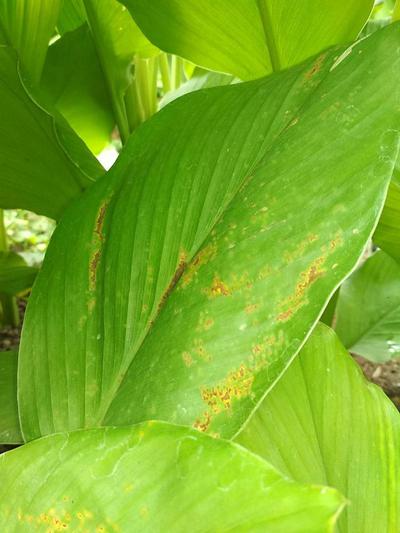Leaf Spot of Turmeric
Colletotrichum capsici
Fungus
In a Nutshell
- Brown spots with grey center.
- Leaves dry and wilt.
Can also be found in
Symptoms
The earliest signs are oblong pale spots with grey centers found on leaves. Individual spots are small, 1-2 mm in diameter. The spots coalesce and become usually about 4-5 cm in length and 2-3 cm in width. In advanced stages of infestation, the black dots become concentric rings. The grey centers become thin and eventually tear. In severe cases of attacks, hundreds of spots appear on both sides of the leaves. Severely affected leaves wilt and dry up.
Recommendations

Organic Control
Apply bioagents such as Trichoderma harzianum and Trichoderma viride which have shown evidence for reduction in disease incidence. Plant extracts of Polyanthia longifolia and bulb extract of onion (Allium cepa) can moderately control the disease.

Chemical Control
Always consider an integrated approach with preventive measures together with biological treatments if available. Treat seed material with mancozeb at the rate of 3 g/l of water or carbendazim at the rate of 1 g/l for 30 minutes and dry in the shade before sowing. When propagated with rhizomes, treat rhizomes with carbendazim and mancozeb and and foliar application of propiconazole at 45 and 90 days after planting. In case the disease becomes significant later in time apply mancozeb at the rate of 2.5 g/l or carbendazim at the rate of 1 g/l. Repeat 2-3 sprays with an intermediate of two weeks . Spraying Blue copper at the rate of 3 g/l was found effective against leaf spot.
What caused it?
The fungus is carried on the scale of rhizomes which is the primary source of infection during planting. The secondary spread is caused by wind, water and other physiological and biological agents. The pathogen can survive on infected debris for a year.
Preventive Measures
- Cultivate tolerant varieties like Suguna and Sudarshan.
- Select seed material from disease free areas.
- Practice regular crop rotations.
- Avoid cultivation next to alternate hosts like chilli.
- Collect infected and dried leaves and burn them to prevent further spread of the disease.


